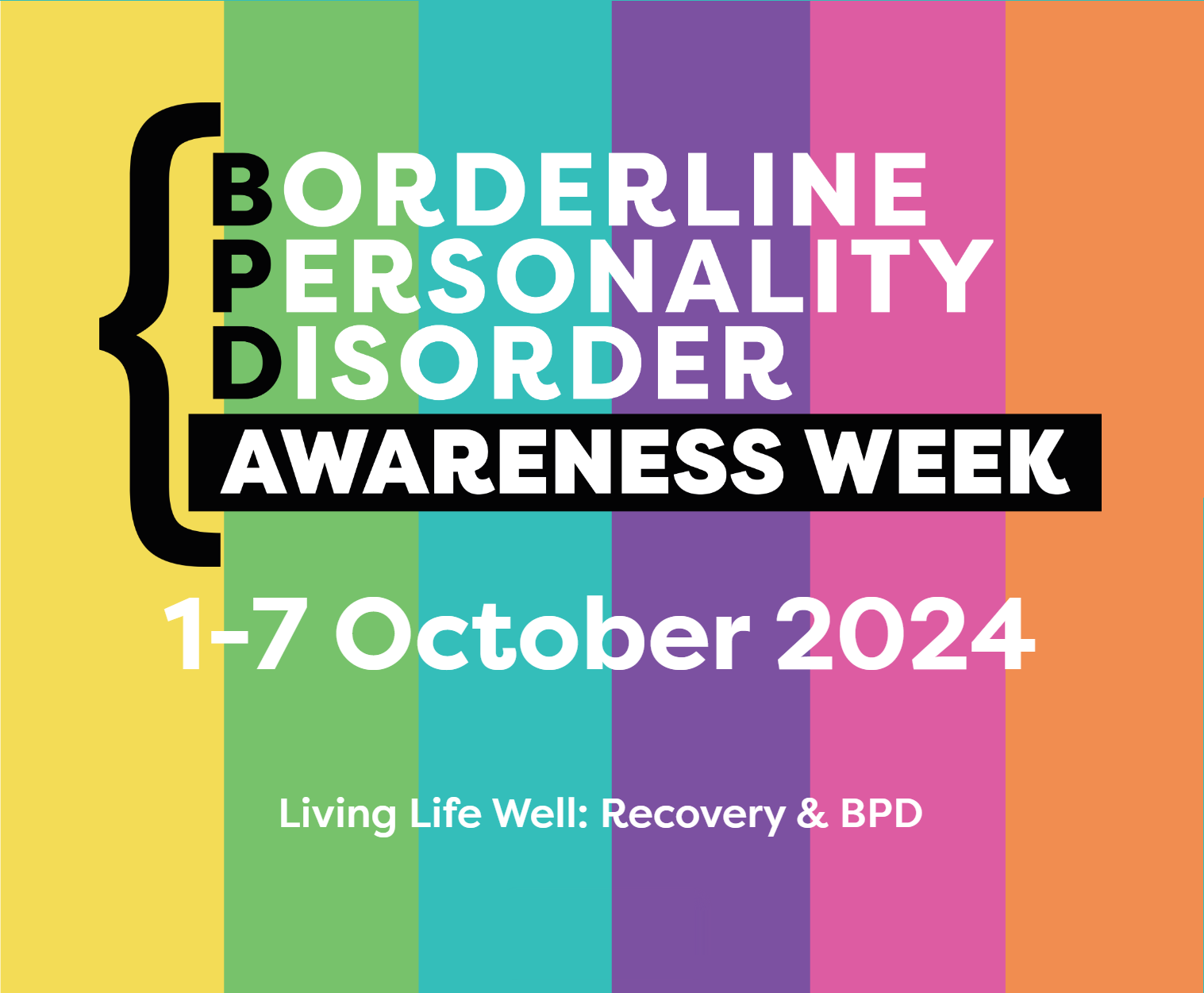Basics of BPD
Meeting Notes, April 2021
Dr Martha Kent spoke about the basics of BPD, and the challenges and recommendations for carers.
What is BPD?
Borderline Personality Disorder (BPD) can be challenging to understand and describe.
The diagnostic criteria from the DSM-5 manual (American) and ICD-11 manual (European) are available here
Martha’s way of describing BPD uses the letters A, B, C, I, and R.
A – Affect (moods, emotions)
• A defining feature of BPD is an intensity of emotional experience (and the intense expression of those emotions). These emotions can shift from moment to moment, day to day and month to month, and are unpredictable.
• These mood swings can exacerbate other illnesses such as PTSD and depression. These other illnesses come and go with BPD and add complexity to an already complex condition.
• Anger is often prominent. It may show as irritability, or aggressive outbursts and often associated with significant agitation and anxiety This can be exacerbated by hypomania (over-active and excited behaviour) especially if people are prone to bipolar affective disorder.
• You have all the kaleidoscope of rapidly changing intense emotions coming and going for no apparent reason
• There is a sense of emptiness or numbness that is very hard to deal with.
• BPD is a strange illness, featuring constant changes.
B – Behaviours
• The drivers include impulsivity, linked to the intensity of mood.
• When someone is captured by a particularly intense mood it drives associated behaviours in an effort to express the mood or to deal with the mood in some way. This is manifested by a whole raft of addictive behaviours such as drug and alcohol misuse, gambling and sexual behaviours.
• May be parasuicidal/suicidal. People with BPD are very prone to self-harm as a way to control and contain their intense emotional pain. Numbness and emptiness can be the most painful emotions.
• The risk of suicide or accidental death (e.g. through accidental overdose) is as high as for schizophrenia and bi-polar disorder.
• Sometimes people self-harm because they have a need to demonstrate how urgent their situation is and can’t find another way to express what they feel.
• They are desperate to communicate the struggle they are having and can find no other reasonable way.
C – Cognition (thinking)
• Black and white thinking, all or nothing, often driven by the mood of the moment.
• Switch quickly from highs to lows.
• Struggle to take responsibility for their actions. They try to blame someone else, often parents.
• People with BPD are in pain like a missing layer of skin and that itself can move to brief or sustained psychosis. Can move from paranoia to psychosis (where thought and emotions are so impaired that contact is lost with external reality).
• Emptiness and dissociation = numbness – “losing time”. It is most unpleasant to be in a dissociative state, and can be very scary. Self-harm can wake them out of it.
• The whole illness is extremely complicated.
• As moods change, the capacity to engage in strategies changes too.
• People with BPD have a repertoire of behaviours – move from one state to another to another. Given this, it is understandable that it is difficult for them to steadily apply themselves to anything.
I – Identity
• Not knowing who they are.
• Difficult to have a stable identity and goals when their life is in chaos.
• Who am I? What are my goals in life? Why am I on this planet?
R – Relationships
• There is typically a lack of steadiness in relationships.
• A common pattern is Idealisation of a new relationship, followed by devaluation.
• There is deep disillusionment when a relationship doesn’t fulfil its potential.
• People with BPD often struggle to be alone. Intolerance of being alone.
• When relationships go pear-shaped this can cause intolerable emotional pain and lead to self-harm.
Causes of BPD
• There is no real all-encompassing explanation as to why BPD occurs. There is such an overwhelming array of considerations that it is hard to pull these back to a cause.
• Both genes and environment – seesaw between these.
• There is a genetic inheritance for many people with BPD. This may be of intense emotion, or BPD itself.
• People with BPD do not always have a history of trauma.
• The more genetics plays a part the less trauma is needed to kick it off. And vice versa. BPD itself generates trauma.
• Environmental factors can be family based, or outside the family e.g. school.
The role of psychiatrists and psychologists
• Psychiatrists provide a 3-D diagnosis. They take a rounded personal history, including genetics and environment, and put it all together.
• They provide medication assessment and prescription. There is no medication specifically for BPD, but medication can assist in a crisis, and help obtain a reduction in intensity of the illness e.g. antidepressants. Medication has a role in treating illnesses but because BPD is difficult to treat, there is the risk that medications accumulate – risk of poly pharmacy.
• Not all psychiatrists are trained in evidence-based therapies (the “talking therapies”)
• Psychologists often use a questionnaire as a method of diagnosis. They are best for therapy.
Advice for carers
• There is no magic wand. Responsibility belongs with the person with BPD, not the carer. You cannot cure them.
• Be kind but firm, particularly with respect to limits. Be as consistent as possible.
• Ask yourself: Is this your problem, or does it belong to the person with BPD?
• The responsibility for recovery lies with the person who has the condition – they have to do some ‘heavy lifting’.
• Do not rescue (doing what they can/should do for themselves). To rescue is to infantilise the person – keeping them functioning as children.
• Apologise if you have made a mistake but if not, do not apologise because of pressure on you to do so. This is very hard when you are being blamed. Important not to be untrue to yourself. Boundaries are important – they show a strong sense of who you are.
• Seek help for yourself e.g., do the (free) Family Connections course (go to www.bpdaustralia.org for information and how to register). Or see a counsellor/psychologist/psychiatrist- important that they understand the complexities of BPD. Seeking help is important in managing your own anxiety. Be and become the sort of person you want the person with BPD to be. Your relationship with yourself has to be strong.
• Do not blame yourself for the diagnosis. Blaming yourself moves the person with BPD away from managing their lives.
• Validate, but hold them responsible for their actions.
• Don’t protect them from the consequences of their actions.
• Encourage responsibility and healthy behaviours while understanding how hard it is for them.
• Continue to maintain optimism. The statistics regarding recovery are encouraging. Be optimistic that they will find their way to a more functional and fulfilling life. We often forget the good things they do.
• Most of this advice is about how to hold yourself steady. It is about preserving yourself and the relationship and expecting that they have the capacity to come through it.
Questions to Martha from carers
Q: Is self-harm attention-seeking behaviour?
A: No, it is an attempt to alleviate their distress. Most self-harm is done in private and in secret. People with BPD often have difficulty articulating their distress. They have an inner pain which is intolerable.
Q: How do I validate?
A: Validating means understanding what the other person is feeling/thinking and communicating that understanding to them.
• Validate their emotions – name the emotion e.g. “I can see you are upset about this/feeling let down/sad/afraid/confused etc”…)
• Don’t offer suggestions or give advice (these are judgments and are very invalidating)
• It is never about you (don’t justify your actions or offer excuses or your thoughts)
• It is not about agreeing or not agreeing. It is just about communicating that you understand how they are feeling or how hard something is.
• Validation is one of the skills taught in the Family Connections program. It takes a lot of practice to do well.
Q: Is there usually a light-bulb moment of realisation for the person with BPD?
A: Many consumers take a long time to realise it is their problem. Some get stuck. It is up to them to do something about it.
Q: Is there a way of coaxing them out of it?
A: Validate their emotions and skills, while holding them responsible for their behaviour. Choose – stand your ground – in Martha’s experience this ultimately improves the relationship. Until they recognise and want to change, nothing will change.
Q: How should I respond to “I may as well kill myself”?
A: Suggest you say something like: “I love you and would be devastated if you did that, and I would never recover. But it is your choice to make that decision, I cannot make that decision for you.”
Q: Are they being manipulative or blackmailing?
A: They operate from learned behaviour which is mostly not conscious. They project their stuff onto you, and you may feel enormous pressure. You must have a strong sense of self and where your responsibility begins and ends, to manage this.
Q: My daughter constantly searches for other causes of her ill health. She’s had comments that she is reluctant to get better.
A: People accumulate a lot including burnt out relationships with therapists. This is part of the idealisation and devaluation. She may need to keep searching until there is no more to search.
Q: What about partners of people with BPD?
A: The attachment issues and dynamics are similar as for parents of children with BPD. There is often a history of insecure attachment. People with BPD need to be close but they often don’t feel connected/satisfied, but they don’t feel confident to move away. “I hate you, don’t leave me”
A difference is that it is difficult for parents not to feel responsible. Partners also have a sense of responsibility, but it is usually less urgent. The principles and approaches for partners and parents are similar.
Image by Milada Vigerova on Pixabay
Related posts
Tuesday 12 November – Next Meeting
Our next Sanctuary meeting will be on Tuesday, November 12, at 6.00pm, in the Marjorie Black Room a
Living Life Well – BPD Awareness Week 2024
This week is BPD Awareness Week and the theme is Living Life Well - Recovery and BPD. Professor Bri
Mental Health Plans for South Australia
In September we were very lucky to have South Australia's Chief Psychiatrist, Dr John Brayley, as ou




